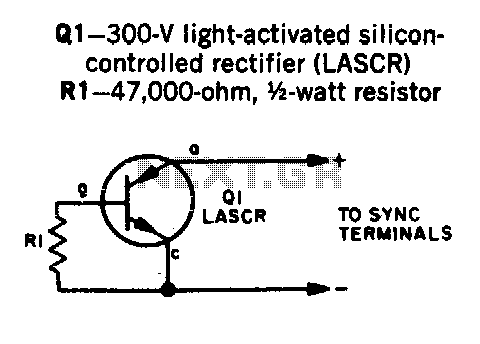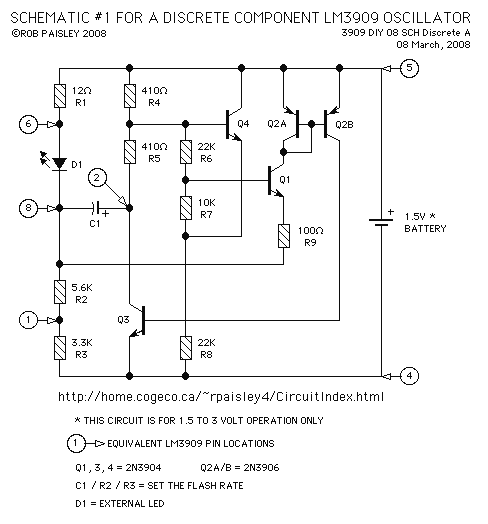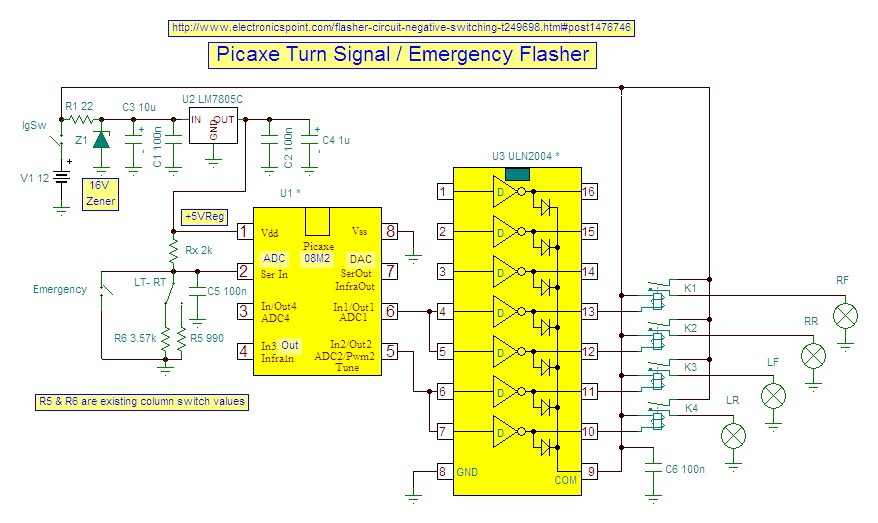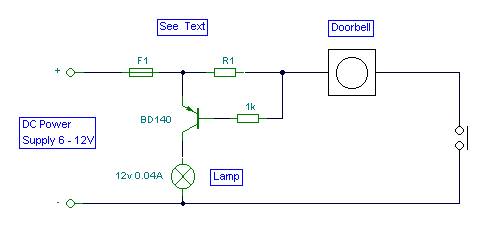
Remote flash trigger

Transistor Q1 is a light-activated silicon-controlled rectifier (LASCR). The gate is activated by light entering a small lens integrated into the top cap. To operate, provide a 6-inch length of stiff wire for the anode and cathode connections, and terminate the wires with a polarized power plug that matches the sync terminals on the electronic flashgun (strobe light). Ensure that the anode lead connects to the positive sync terminal. When using the device, position the connecting wires so that the LASCR lens is directed towards the main flash. This setup will trigger the remote unit.
The light-activated silicon-controlled rectifier (LASCR) is a specialized electronic component designed for applications requiring light sensitivity, particularly in triggering circuits. The device operates by utilizing a small lens that captures incoming light, which subsequently activates the gate of the LASCR. This activation allows current to flow from the anode to the cathode, enabling the device to function as a switch in electronic circuits.
To implement this circuit effectively, a 6-inch length of stiff wire is recommended for the anode and cathode connections. This wire should be securely connected to a polarized power plug, ensuring compatibility with the sync terminals of the electronic flashgun. The polarized design is crucial as it provides correct orientation, preventing potential damage to the circuit due to incorrect connections. It is imperative to connect the anode lead to the positive sync terminal, as this configuration is necessary for the proper operation of the LASCR.
In practical applications, the positioning of the LASCR is critical. The connecting wires should be bent in such a way that the lens of the LASCR directly faces the main flash source. This alignment maximizes the light exposure to the lens, ensuring reliable triggering of the remote unit. The LASCR will respond to the light pulse emitted by the flash, allowing for synchronization in photography or other light-activated applications.
Overall, the LASCR setup provides a robust solution for remote triggering, combining light sensitivity with electronic control, making it an invaluable component in various electronic flash systems. Proper attention to wiring, connections, and positioning will ensure optimal performance and reliability in circuit operation.Transistor Ql is a light-activated silicon-controlled rectifier (LASCR). The gate is tripped by light entering a small iens built into the top cap. To operate, provide a 6-in. length of stiff wire for the anode andcathodeconnections and terminate the wires in a polarized power plug that matches the sync terminals on your electronic flashgun (strobelight). Make certain the anode lead connects to the positive sync terminal When using the device, bend the connecting wires so the LASCR lens faces the main flash. This will fire the remote unit.
The light-activated silicon-controlled rectifier (LASCR) is a specialized electronic component designed for applications requiring light sensitivity, particularly in triggering circuits. The device operates by utilizing a small lens that captures incoming light, which subsequently activates the gate of the LASCR. This activation allows current to flow from the anode to the cathode, enabling the device to function as a switch in electronic circuits.
To implement this circuit effectively, a 6-inch length of stiff wire is recommended for the anode and cathode connections. This wire should be securely connected to a polarized power plug, ensuring compatibility with the sync terminals of the electronic flashgun. The polarized design is crucial as it provides correct orientation, preventing potential damage to the circuit due to incorrect connections. It is imperative to connect the anode lead to the positive sync terminal, as this configuration is necessary for the proper operation of the LASCR.
In practical applications, the positioning of the LASCR is critical. The connecting wires should be bent in such a way that the lens of the LASCR directly faces the main flash source. This alignment maximizes the light exposure to the lens, ensuring reliable triggering of the remote unit. The LASCR will respond to the light pulse emitted by the flash, allowing for synchronization in photography or other light-activated applications.
Overall, the LASCR setup provides a robust solution for remote triggering, combining light sensitivity with electronic control, making it an invaluable component in various electronic flash systems. Proper attention to wiring, connections, and positioning will ensure optimal performance and reliability in circuit operation.Transistor Ql is a light-activated silicon-controlled rectifier (LASCR). The gate is tripped by light entering a small iens built into the top cap. To operate, provide a 6-in. length of stiff wire for the anode andcathodeconnections and terminate the wires in a polarized power plug that matches the sync terminals on your electronic flashgun (strobelight). Make certain the anode lead connects to the positive sync terminal When using the device, bend the connecting wires so the LASCR lens faces the main flash. This will fire the remote unit.





